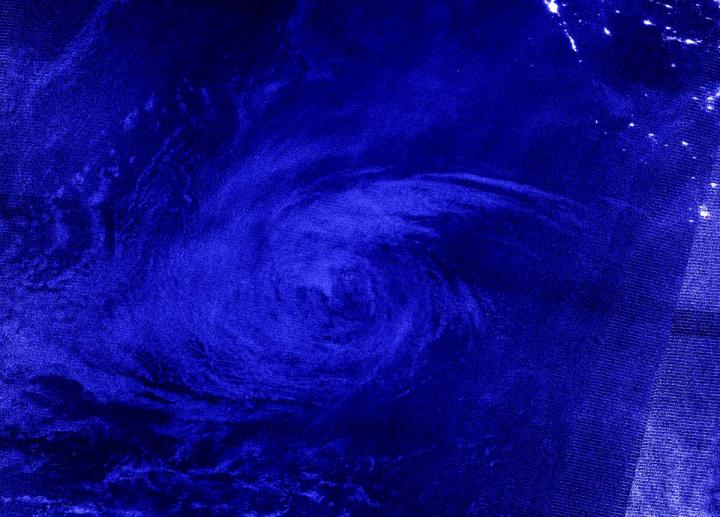
Credit: Credit: NASA Worldview, Earth Observing System Data and Information System (EOSDIS)
Tropical Storm Karina was making night moves like the old Bob Seger song. NASA-NOAA’s Suomi NPP satellite provided an infrared image of Tropical Storm Karina’s nighttime movement as it moved away from the Baja California peninsula of Mexico. Infrared data showed the storm was weakening.
NASA’s Night-Time View of Karina’s Weakening
The Visible Infrared Imaging Radiometer Suite (VIIRS) instrument aboard Suomi NPP was used to capture a nighttime image of Karina. NASA-NOAA’s Suomi NPP satellite passed over the Eastern Pacific Ocean during the early morning of Sept. 16 at 3 a.m. PDT/6 a.m. EDT (1000 UTC) and captured a nighttime image of Tropical Storm Karina moving farther away from Baja California, Mexico.
The infrared imagery revealed that there was very little deep convection (and building thunderstorms). Cloud top temperatures were near minus 40 degrees Celsius, which indicates they are warming and cloud heights are dropping. It is an indication that the uplift in the storm is weakening, and thunderstorm development drops off. The coldest cloud tops were found well to the west-northwest of the center of circulation.
The image was created using the NASA Worldview application at NASA’s Goddard Space Flight Center in Greenbelt, Md.
Karina’s Status on Sept. 16
At 11 a.m. EDT (1500 UTC), the center of Tropical Storm Karina was located near latitude 22.6 degrees north and longitude 123.9 degrees west. Karina is moving toward the northwest near 8 mph (13 kph), and a turn back toward the west-northwest is forecast today. A slower westward motion is expected toward the end of the week. Maximum sustained winds are near 40 mph (65 kph) with higher gusts. Continued weakening is forecast, and Karina is expected to become a remnant low by tonight. The estimated minimum central pressure is 1004 millibars.
Karina’s Forecast
“Karina is expected to continue traversing cooler waters while moving farther into an inhibiting thermodynamic environment and unfavorable upper-level winds,” noted U.S. Navy Hurricane Specialist Dave Roberts of NOAA’s National Hurricane Center in Miami, Fla. “Therefore, weakening is forecast and Karina should degenerate to a remnant low [pressure area] tonight.”
###
About NASA’s EOSDIS Worldview
NASA’s Earth Observing System Data and Information System (EOSDIS) Worldview application provides the capability to interactively browse over 700 global, full-resolution satellite imagery layers and then download the underlying data. Many of the available imagery layers are updated within three hours of observation, essentially showing the entire Earth as it looks “right now.”
NASA Researches Earth from Space
For more than five decades, NASA has used the vantage point of space to understand and explore our home planet, improve lives and safeguard our future. NASA brings together technology, science, and unique global Earth observations to provide societal benefits and strengthen our nation. Advancing knowledge of our home planet contributes directly to America’s leadership in space and scientific exploration.
For updated forecasts, visit: http://www.
By Rob Gutro
NASA’s Goddard Space Flight Center
Media Contact
Rob Gutro
[email protected]
Original Source
https:/




